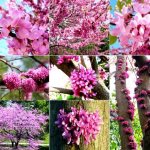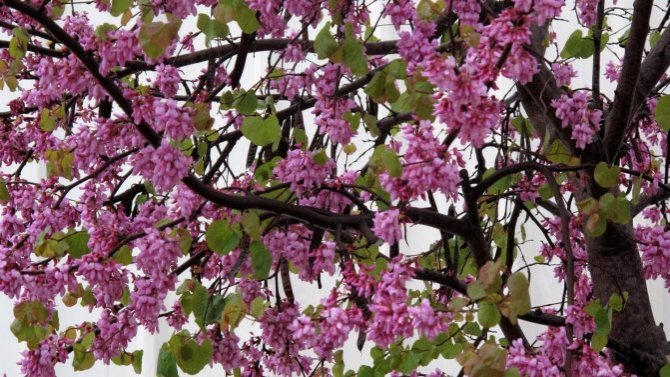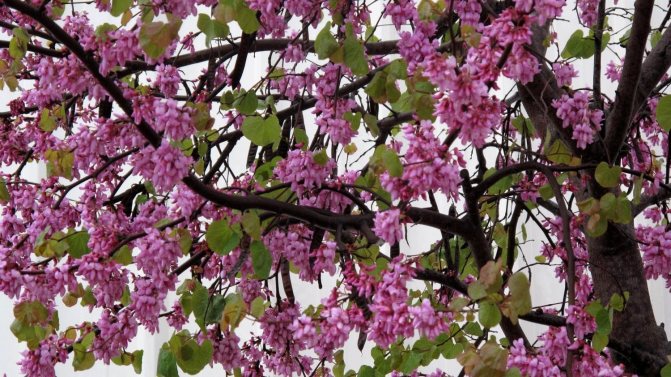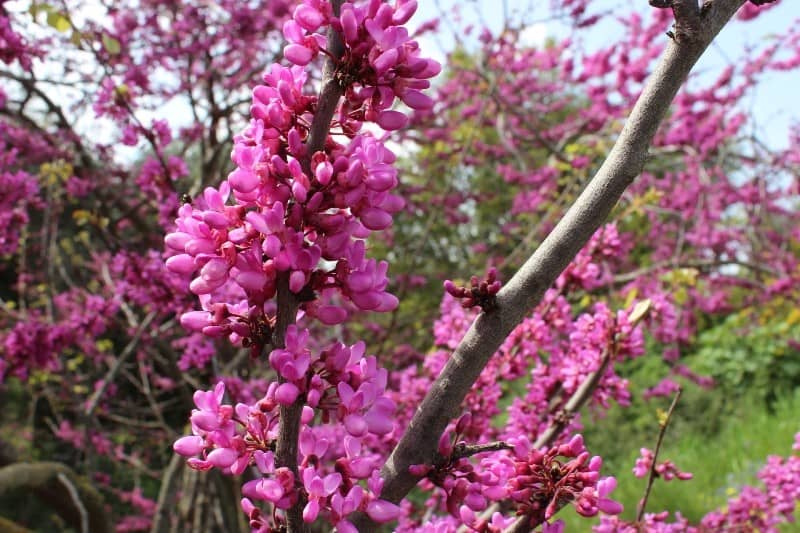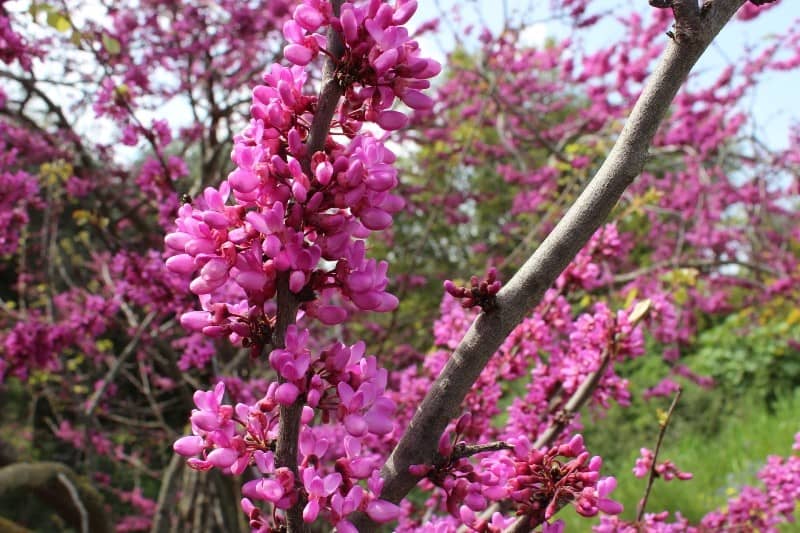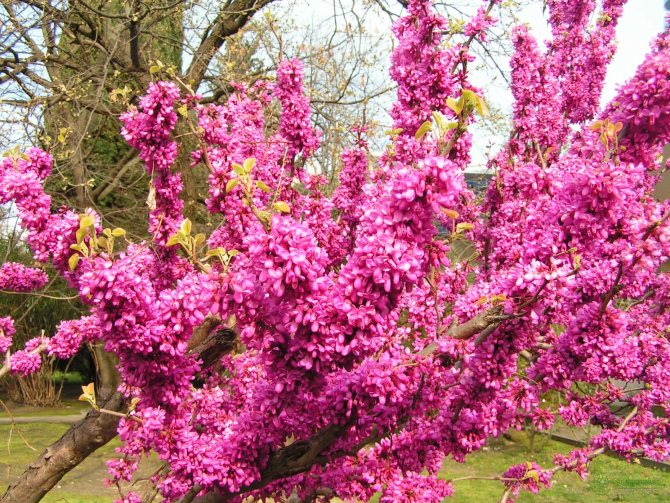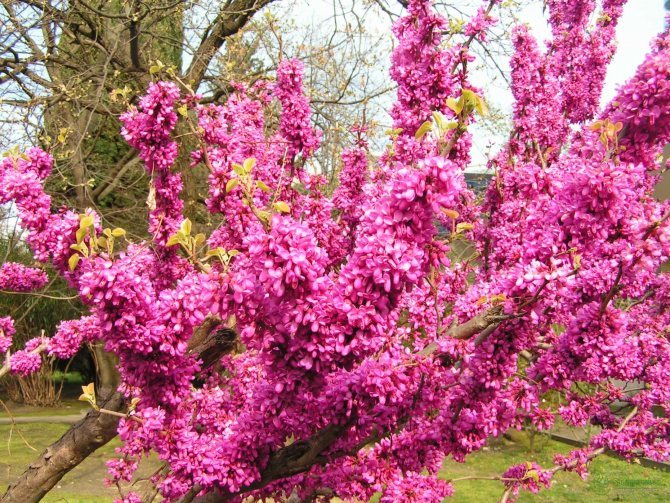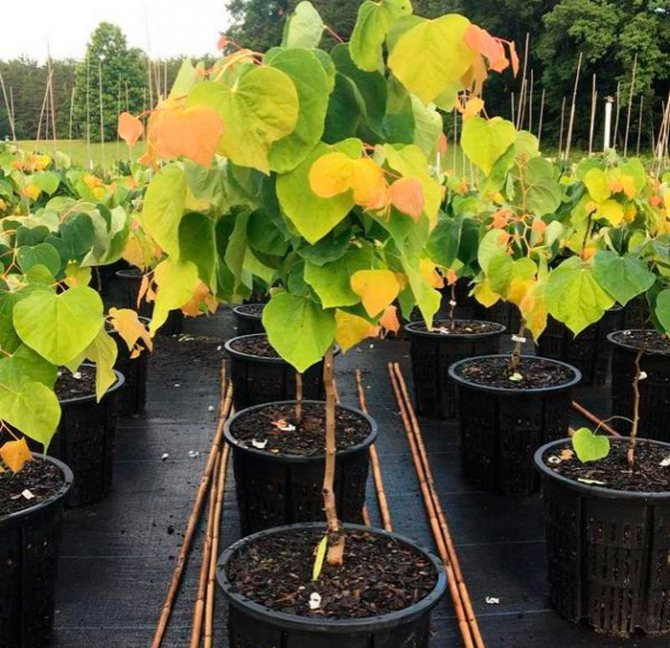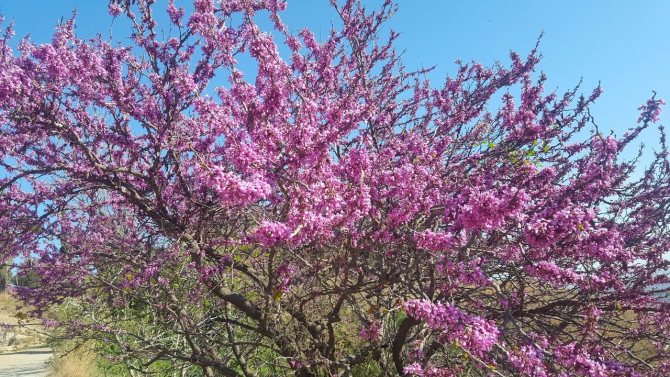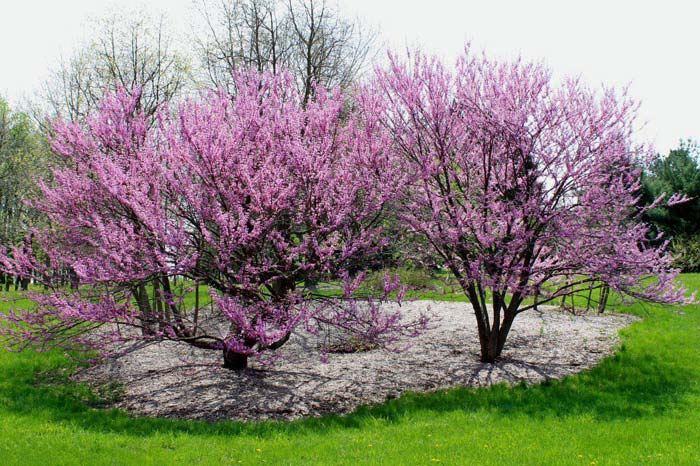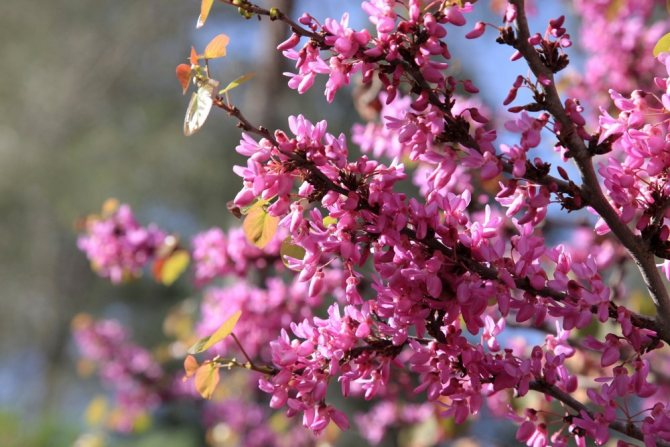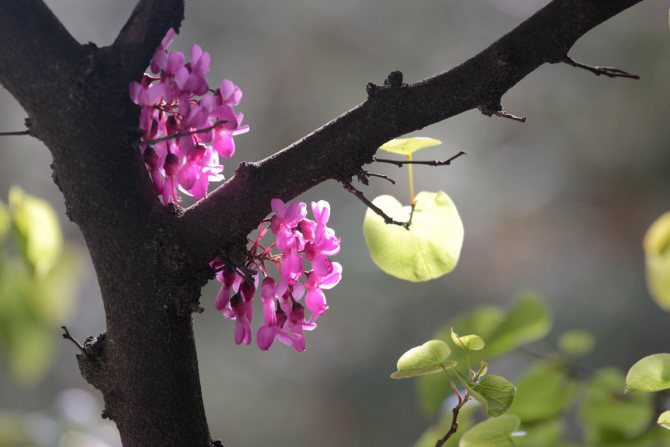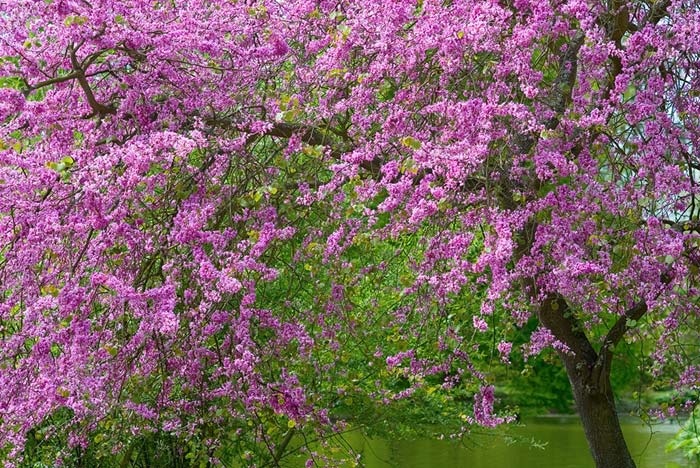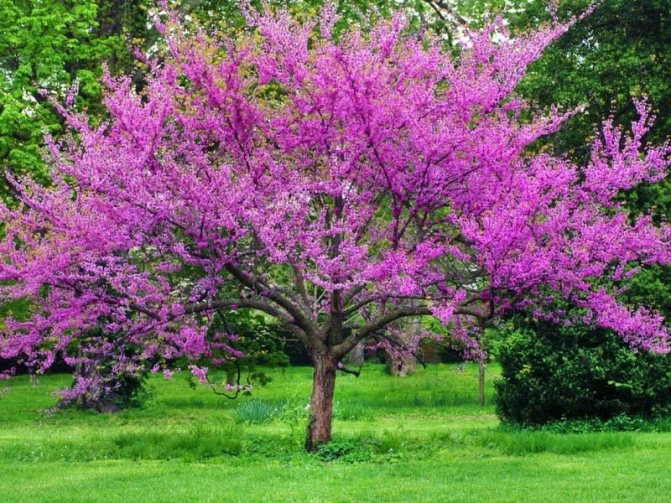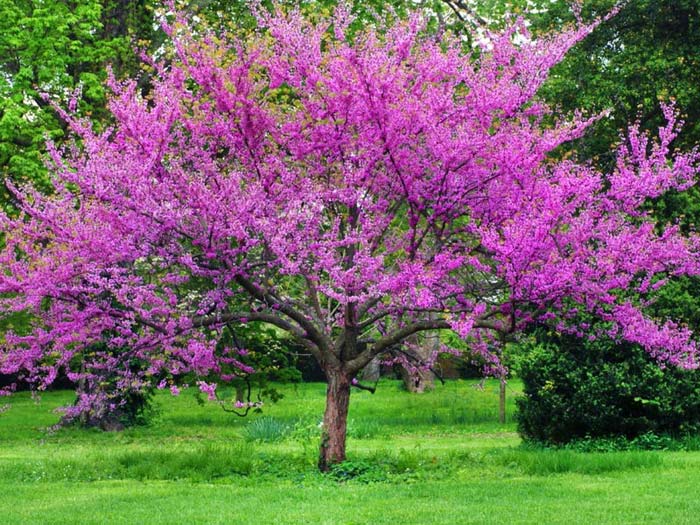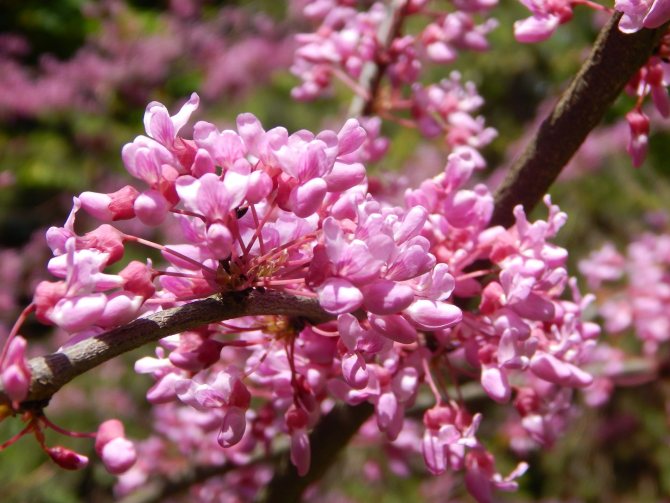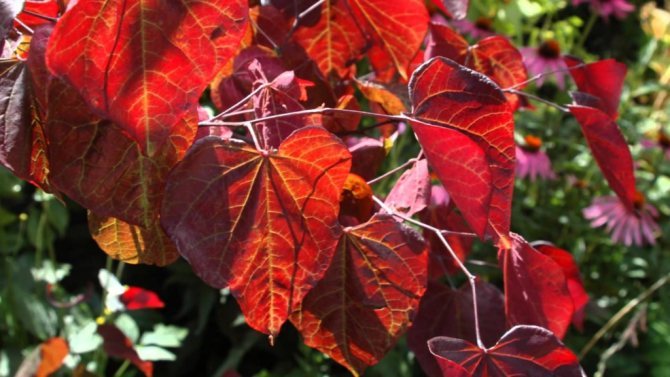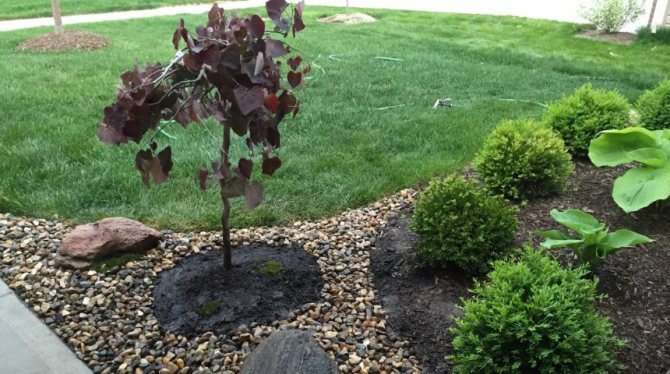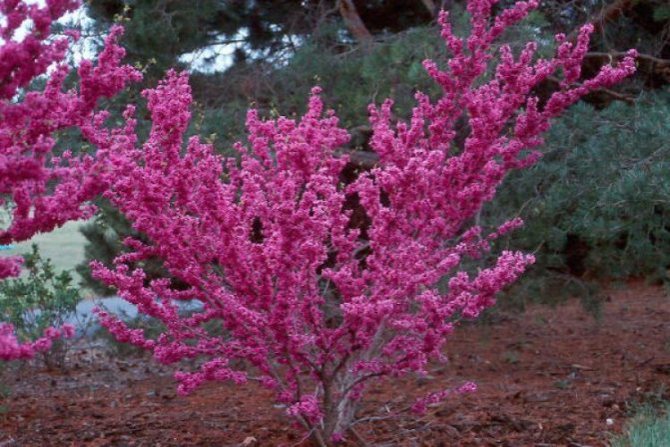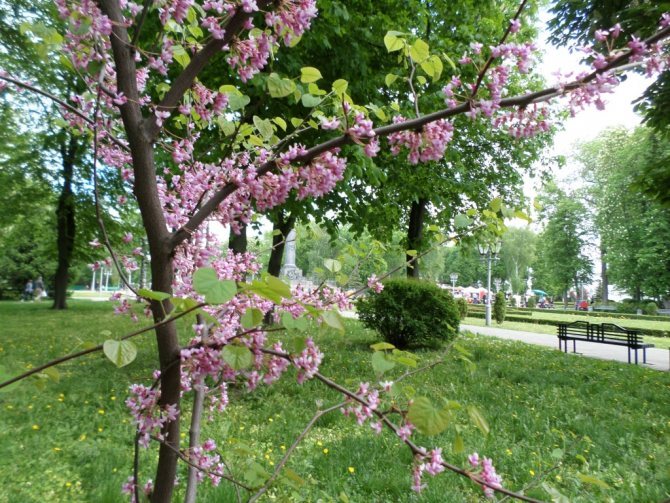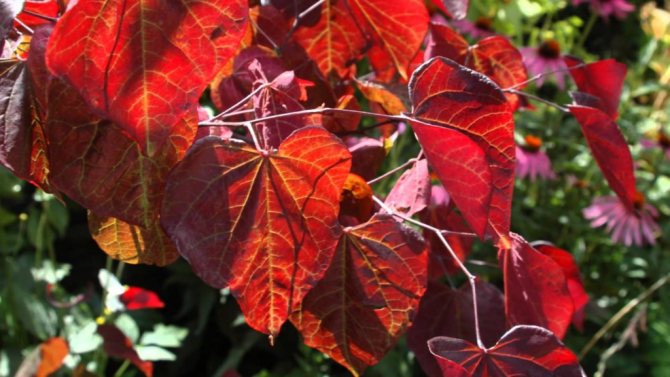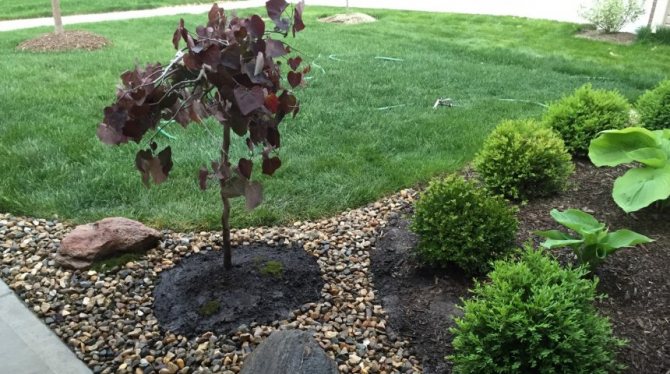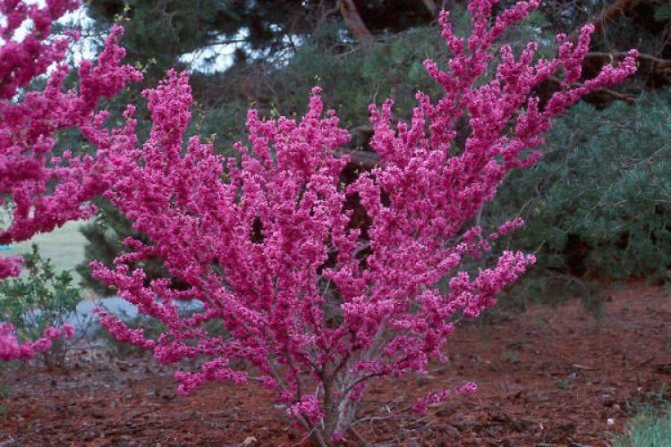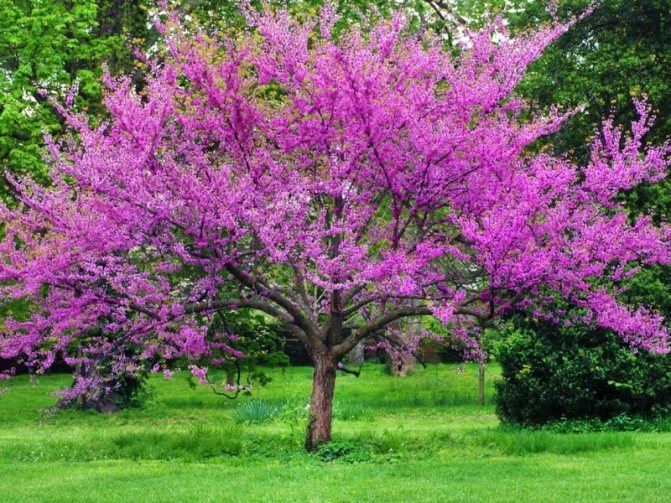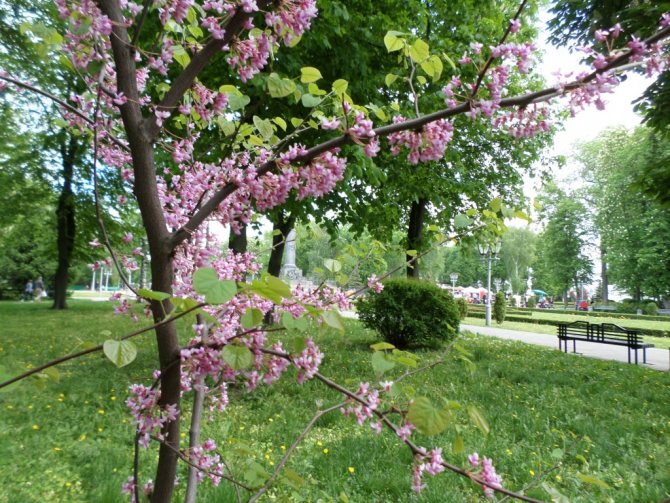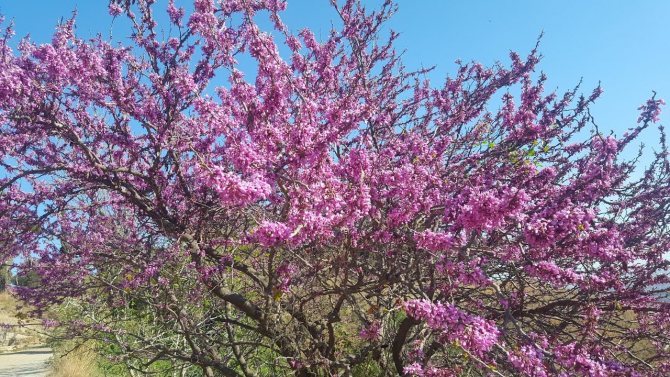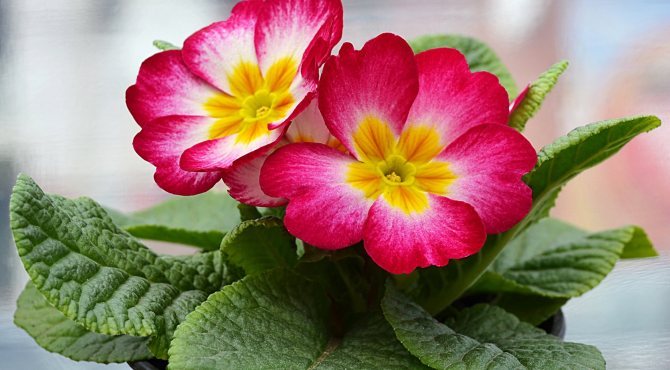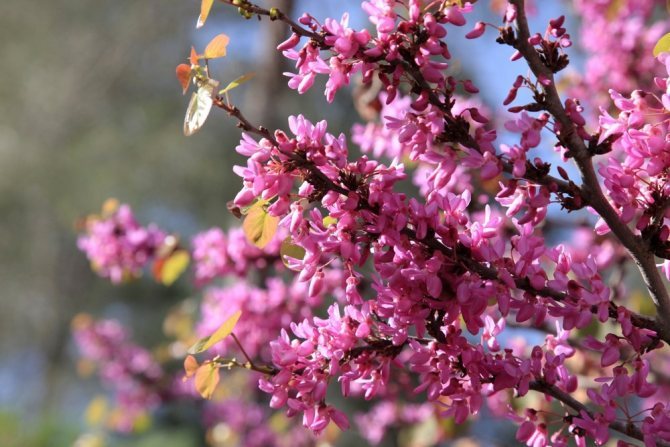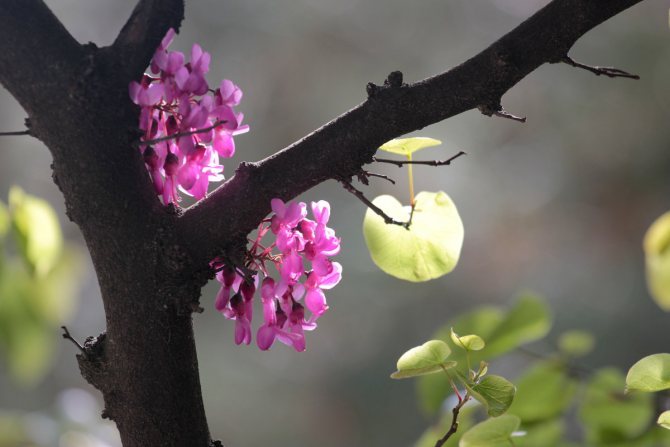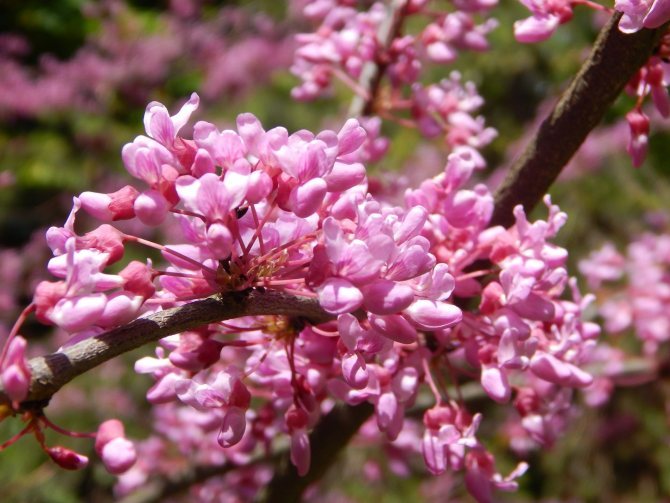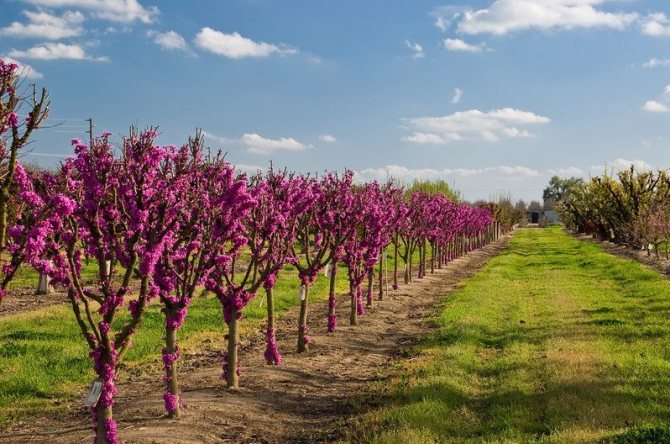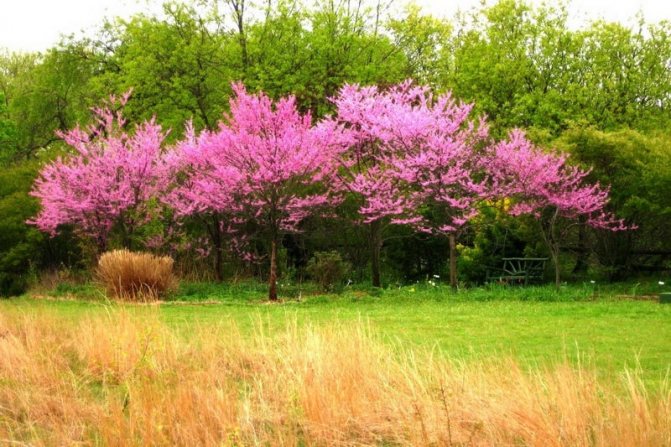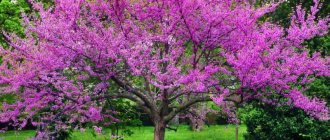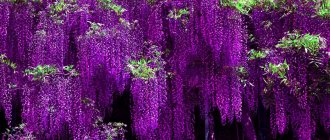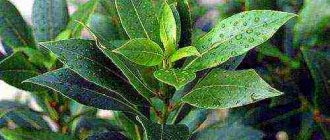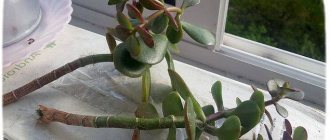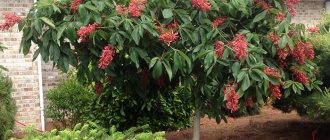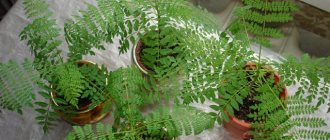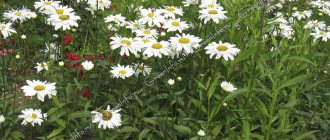Appearance
Cercis European , or the so-called Judas tree, grows in many European countries, as well as in North America, Canada and the United States. The Canadian subspecies of cercis easily tolerates cold winters. More precisely, it is a perennial shrub that belongs to the legume family. Key Features:
- The plant has bright green, rounded leaves, shaped like an egg;
- In the spring, when the time for flowering comes, bright pink flowers bloom in unison on the bush. At this time, cercis is somewhat remotely reminiscent of Japanese sakura, only the flowers have more rich, juicy pink shade ;
- When the flowers fall, pods appear in their place, inside which are rounded beans that resemble beans. You cannot eat them;
- He has a very powerful, branched root system.
Bloom
The scarlet is irresistible at the time of its flowering, which begins in April-May, when almost completely the entire tree, and often the trunk, is covered with magnificent fragrant flowers collected in bunches of bright pink, purple, lilac, lilac, purple or white color. This is an unforgettable sight. The development of flowers directly on thick branches and trunk is called caulifloria in botany and is more typical for some tropical crops.
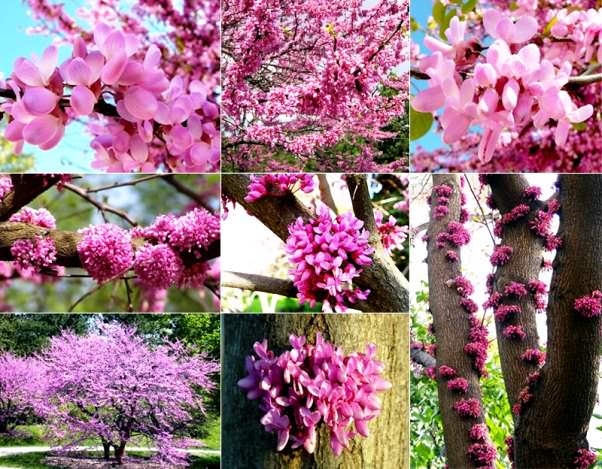
The flowers of the plant are edible, have a sweet and sour exotic taste and can be used in cooking. Flowering ends simultaneously with the appearance of leaves. At its end, in place of flowers, long bean-like, dry, brown and flattened pods are tied, the seeds in which ripen at the end of summer.
Cercis: description, types and varieties
Cercis belongs to the legume family (Fabaceae). It is a deciduous tree or ornamental shrub that gets its name from the ancient Greek name for the weaving shuttle, which is associated with the shape of its fruit. 7-10 species belong to the genus Cercis, but many of them do not winter in our latitudes, so here we will give only three of them:
- Certsis European (C. siliquastrum), c. an ordinary or Judas tree is a Mediterranean species that has long been used for landscaping squares in the Caucasus and Crimea. In favorable conditions, it reaches 12 m, and in more northern zones it grows like a shrub. This species was previously confused with the scarlet (Certidiphyllum japonicum), which has showy leaves and is often used in Japanese gardens;
- Chinese cercis (C. chinensis) is not very common in the CIS countries and was hardly worth including in this list, but when you see a flowering tree in Barcelona among a clipped hedge, it is impossible to forget it. Surely there are cultivars that grow confidently in temperate climates;
- Certsis canadensis (C. canadensis) is the most winter-hardy species with a wide spreading crown, 6-10 m tall, originally from North America. There are varieties with purple and light green foliage, as well as drooping branches. The following varieties bloom very beautifully:
|
|
|
|
|
|
|
|
The most frost-resistant is the Canadian one, which allows it to be grown in the European part of Russia. But it should be borne in mind that north of the Voronezh region is too cold for him. The plant begins to freeze slightly and does not bloom annually.If you plant canadian cercis in the climatic conditions of the Moscow region, then it will not please with lush flowering or beautiful appearance. Like many plants from the "risk group", it will not die, but it will not actively grow and bloom.
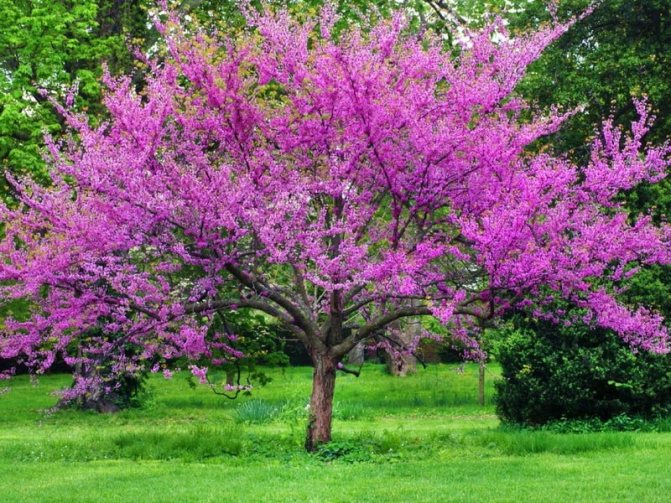

In its habitat, it looks like a tree, reaching twelve meters in height. With a change in conditions, i.e. when grown in colder climates, the appearance also changes: instead of a woody form, a shrub version is obtained. The changes concern not only the life form of the plant, but also the peculiarities of flowering. Flowers become smaller, their number on the branches decreases.
The flowering of cercis occurs in early spring, in the same period as wisteria. At this time, the leaves on the branches have not yet blossomed and the whole plant is covered only with bright pink, less often white flowers, which are arranged in bunches. Flowers are found not only on the branches. They often emerge from dormant buds on the surface of the trunk or thick branches. This phenomenon is called caulifloria in botany and is quite rare.
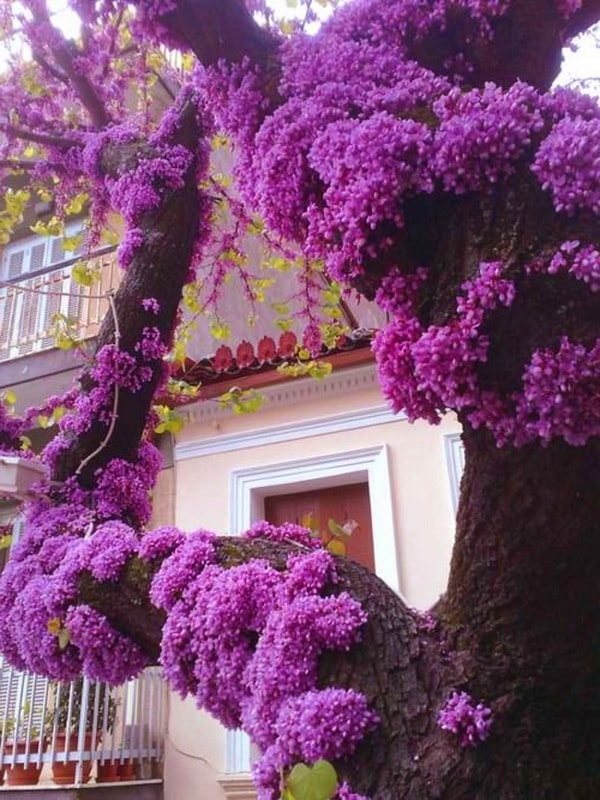

Leaves begin to bloom before flowering ends. They are heart-shaped. In autumn, immediately after the first frost has passed, the leaves of cercis turn red-yellow and orange.
Botanical description
Under favorable conditions, cercis grows up to 18–20 m and lives up to 70–80 years. Branched trunks are covered with dark brown or almost black furrowed bark, young shoots are grayish-green or reddish, darken with age. The crown is spherical, dense. The leaves are heart-shaped, bright green, smooth. On the shoots are located next.
Bisexual small flowers have an irregular shape, resemble butterflies, collected in paniculate inflorescences... They open before the leaves appear. In April, the shrub is strewn with bright pink, red or lilac brushes. In many species, flowers are formed on the shoots and bark of the trunks. In autumn, up to 10 cm long bolls with 6-10 large flattened seeds ripen. The fruits are stored on the branches for several years.


History of the name
When domestic gardeners are asked what a Judas tree is, many answer as follows: "This is an aspen on which Judas hanged himself." However, this is generally accepted only in Russia. In Western Europe, the name "Judah's Tree" (in English it sounds like "Judah's Tree") refers specifically to Cercis. There are two versions regarding the origin of this interesting name. The first version claims that cercis was one of the most common trees in ancient Judea (on the territory of modern Israel and Palestine), hence the name - "Judah").
However, there is another version of this unusual name. It dates back to biblical times. The Gospel says that one of the apostles - the first disciples of Jesus Christ - was Judas. Unlike other disciples of Christ, he did not have sincere faith in him. Judas differed from his comrades in such negative character traits as:
- Selfishness;
- Deceit;
- Passion for profit;
- Readiness for meanness and betrayal.
Subsequently the name "Judas" has become a household name , and now they call every person who is ready for meanness for the sake of getting rich. When Jesus Christ had dinner with his disciples for the last time, Judas went and handed him over to the authorities. For this he received thirty silver coins. However, Judas soon began to suffer from pangs of conscience. He realized that he had betrayed his beloved teacher in vain, and realized that he was to blame for his earthly death. Judas no longer rejoiced at the money he received, because everyone turned away from him.
Tormented by grief and pangs of conscience, he went where his eyes would look, came to a grove and hanged himself on a tree. Nearby was a wonderful tree with snow-white flowers (this was cercis).
When the tree saw what happened to Judasthe delicate flowers took pity over this unfortunate sinner, felt compassion for him.The beautiful tree was so upset by the inglorious death of Judas that the snow-white flowers turned purple. The color purple is traditionally considered the color of grief and sadness in many countries. This is how cercis appeared - a plant covered with pink, purple or purple flowers.
Pruning purple
Autumn pruning is formative. If necessary, the branches are shortened by a third of the length, the emerging root growth is also removed, as well as all deforming branches and those that are knocked out of the general picture. Simply put - we get the desired crown shape.
It is worth noting that due to the slow growth of the plant, formative pruning is carried out annually only for the first 3-5 years of growth, and then practically stops. The only pruning is the damaged branches, the so-called sanitary pruning.
In the case of planting other plants next to the purple, it must be remembered that its root system develops in such a way that at first it deepens by about a meter, and then diverges along a horizontal plane to the sides. For this reason, you should not place any other plants in the immediate vicinity of the tree.
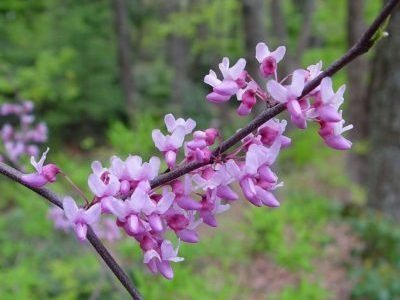

Beneficial features
Doctors and biologists say that the leaves of cercis contain flavonoids - substances that have antibacterial and anti-inflammatory effects. Bioflavonoids, which are found in the leaves of cercis, kill Koch's bacillus (this is a microorganism, which is considered the causative agent of tuberculosis) and contribute to the healing of pulmonary tuberculosis and bone tuberculosis.
The healing properties of cercis were also known in ancient China. Chinese used plant bark for external use. Local healers believed that the cercis bark has an antibacterial effect, relieves inflammation and disinfects wounds. The bark of a plant, ground and pounded into powder, was applied to open wounds, abscesses and ulcers. It was believed that this contributes to the early healing of the wound surface.
Description of the tree canadian cercis
Cercis Canadian (Cercis canadensis L.) belongs to the Leguminosae family. 7 species of deciduous trees and shrubs belong to the genus Certsis (hereinafter cercis - c.).
Two kinds: c. Chinese (C. chinensis Bunge) and c. cystic (C. racemosa Oliv), come from the central and western regions of China. Two more species live in the Middle East, in the southwest of the Pamir-Alai, in mountainous Turkmenistan, Iran, Afghanistan, and in the only corner of the Caucasus - the Shvanidzor Gorge.
it c. Judas tree (C. siliquastrum L.) and c. Griffith (C. Griffitii Boiss.).
Three North American species, c. nodular (C. reniformis Engelm.), c. west (C. occidentalis L.) and c. Canadian (C. canadensis L.) live in the United States, Canada and Mexico.
The name of the genus comes from the Latin word "cercis", which means "weaving shuttle" - probably, two fused lower petals of cercis flowers are similar to this attribute of weaving, or, according to another version, parts of weaving looms were made from wood.
Cercis canadensis or canadian scarlet is a large tree, 12 m in height, with large dark green foliage with a bluish tint, yellow in autumn. The crown is tent-shaped. The bark on the branches and trunk is gray-black, young shoots are red.
As you can see in the photo, the Canadian cercis foliage is wide-oval or heart-shaped, at the very top it is blunt-pointed, smooth:
When describing the Canadian cercis, special attention should be paid to its light pink flowers. They are smaller than that of the European one, but this is compensated by their number: bunches of 5-8 flowers make the shrub stylish and distinctive. In August, the beans ripen, which can hang on the trees for about two years.
A perennial plant usually lives for 50 to 70 years. Shrubs or trees shed their foliage for the winter. Their maximum height is 18 m.
Varieties
In our country, the most common types of cercis are Canadian and European.
Cercis European it is very decorative. In spring, its branches turn almost completely pink due to the abundant flowering. The plant is thermophilic, does not tolerate prolonged frosts, therefore it is suitable for growing in the southern regions. Most often it grows in the form of a tree, but due to the basal shoots it can look like a large shrub. The height of an adult plant can reach 10 m. The trunk is thick, the crown is spreading, the leaves are semicircular. In autumn, the leaves turn bright yellow. Flowers appear in early spring before the leaves open and wither after a month. The color of the petals is bright pink.
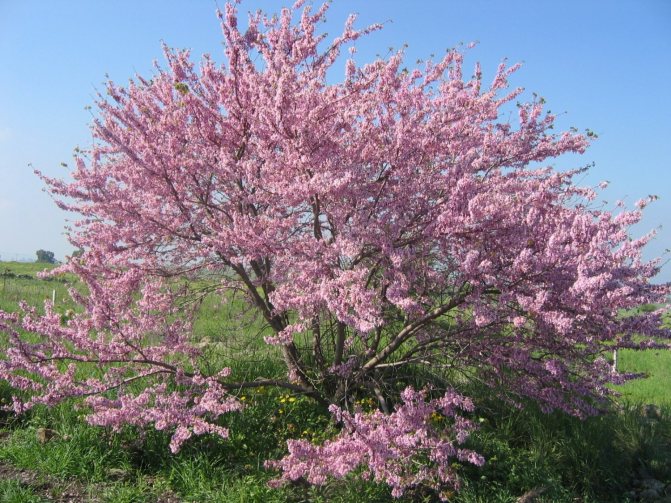

Cercis European
Cercis Canadian more common in the northern regions and is resistant to severe frosts. The trees are taller than the previous species and reach 12 m. The foliage is large, heart-shaped, green above and bluish below. Smooth leaves turn yellow in autumn. The light pink flowers are smaller than the European variety and cover the stems less densely. But still, the branches and even the trunk are covered with dense bunches of 5-8 flowers. Flowering begins somewhat later and lasts until the beginning of summer. The beans ripen in August and do not fall off for a long time, some of them remain for two years. This species has two hybrid varieties:
- white;
- terry.
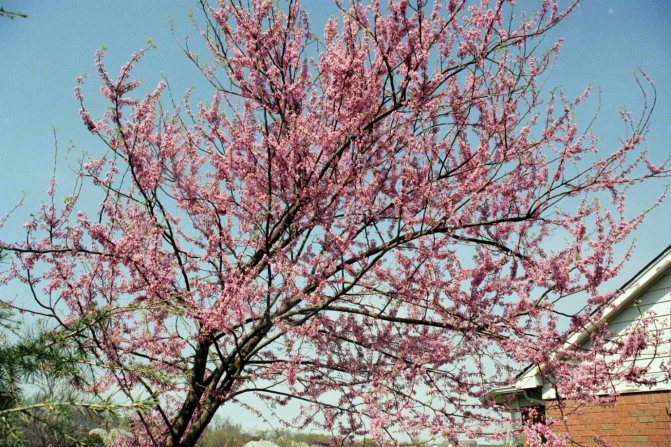

Cercis Canadian
Cercis Chinese represents very tall (up to 15 m) trees with large heart-shaped leaves. The plant is thermophilic and does not tolerate frost. Bright purple-pink flowers are gathered in large bunches, which make the tree very elegant in May.
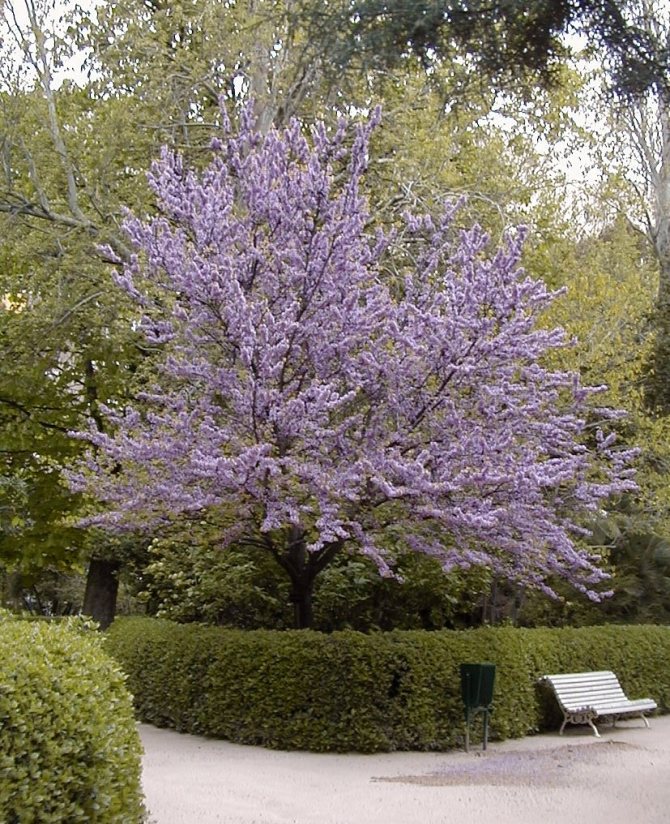

Cercis Chinese
Cercis Griffith unlike previous species, it forms a tall shrub with stiff shoots. Plant height reaches 4 m. The foliage is round, dark green, leathery. Flowers are collected in clusters of 5-7 pieces and have a pink-purple color. Does not hibernate in temperate climates.
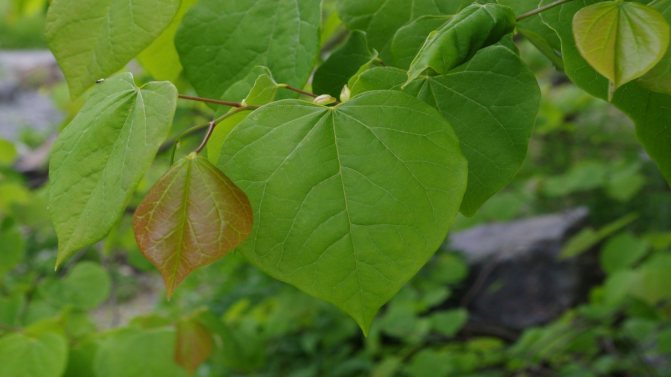

Cercis Griffith
Cercis western... The frost-resistant trees are characterized by a highly branched crown and bright green foliage. The rest of the species is similar to the Canadian one.
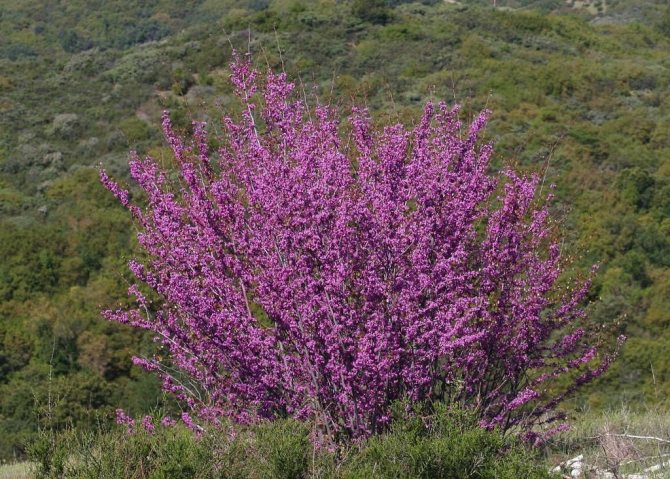

Cercis western
Cercis reniform develops in the form of a large shrub or tree with a maximum height of 10 m. The plant is thermophilic, differs in the shape of inflorescences. The buds are collected in small drooping racemes on shortened pedicels. The length of the inflorescence is about 10 cm. The color of the flowers is bright pink. The foliage is oval, smooth, dark green in color.
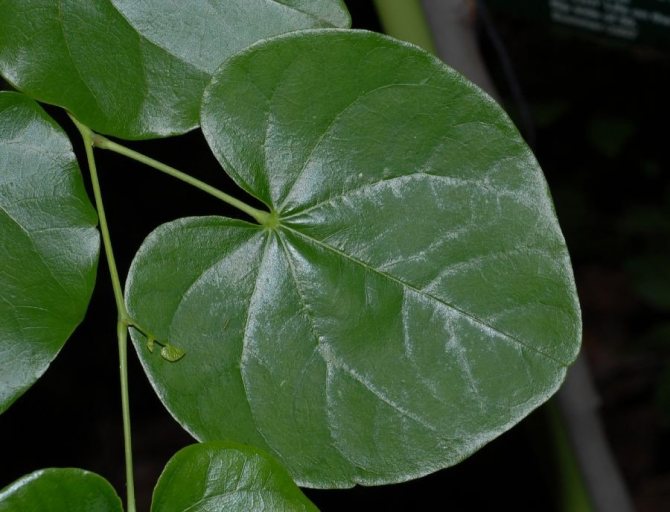

Cercis reniform
Cercis cystic lives in the central part of China. A large tree with a dark green crown in summer and yellow leaves in autumn. In spring, it blooms in purple. The buds are collected in large clusters, both tightly sitting on the branches and trunk, and falling on short pedicels.
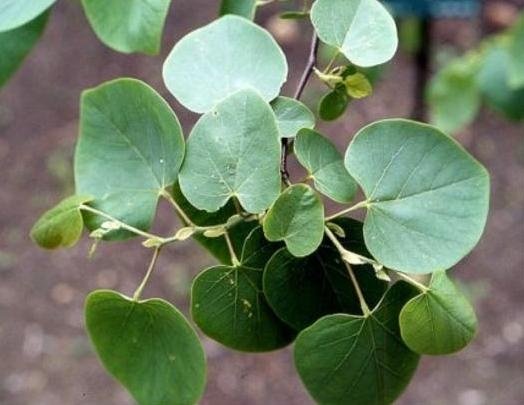

Cercis cystic
Judas tree as a honey plant
Cercis European is an excellent honey plant. Many amateur beekeepers plant this tree in their private apiaries. The bright flowers of cercis attract bees, and honey obtained from the pollen of the flowers of the Judah tree has many beneficial properties. Cercis honey is quite rare on the market. It has a thick consistency and golden brown color. Beekeepers note its high taste: honey has a pleasant, slightly tart taste, with a bright floral aroma. The honey of the Judas tree, just like the leaves of the plant, is rich in useful bioflavonoids. He has the following beneficial properties:
- Stops chronic and acute inflammation;
- Destroys pathogenic bacteria and expels parasites from the body;
- It is used in the treatment of diseases of the upper and lower respiratory tract (bronchitis, pneumonia, laryngitis and tracheitis);
- It has a beneficial effect on digestion and stimulates metabolism.
In order to get a sufficient amount of honey from cercis, several trees should be planted in the apiary, in different places or together, in a group.
Decorative use
In landscape design, they are used for single and group plantings. The main advantage of scarlet is that it is decorative at any time of the year: in the spring it gives a luxurious flowering, in the summer it pleases the eye with large foliage of a beautiful shape, in the fall the leaves change color, and the fruits - beans - acquire aesthetics. In group planting, it goes well with leguminous plants and various types of conifers. It is used for landscaping parks. Taking advantage of the slow-growing cercis, it is sometimes grown in bonsai form.
Interesting fact: in Chinese medicine, the bark of scarlet bark is used as an antiseptic.
Cercis Canadian
It comes from the northern regions, among all representatives of this genus, frost-resistant and therefore, it can be grown in our regions. The places of its growth - from New York to North Florida, to Iowa, Texas.
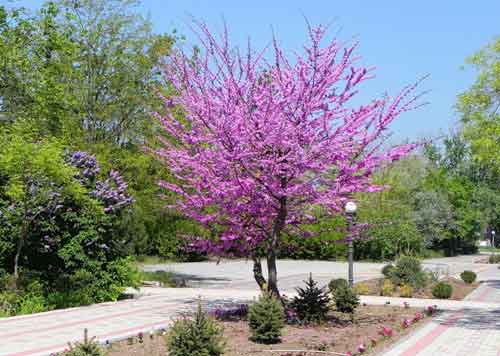

Cercis Canadian - a large tree, 12 m in height, with large dark green foliage with a bluish tint, yellow in autumn. The foliage is broadly oval or cordate, blunt-pointed at the very top, smooth. The flowers of the Canadian cercis are light pink a little less than that of its European, but this is compensated by their number: bunches of 5-8 flowers make the shrub stylish and distinctive. In August, the beans ripen, which can hang on the trees for about two years.
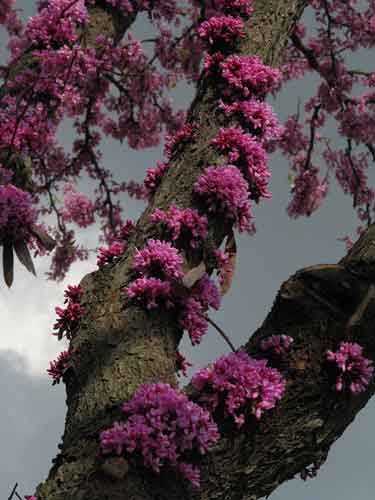

Cercis canadensis seeds need scarification .
Cercis is used in Kaliningrad, grows without problems in the Volgograd region, the North Caucasus and Voronezh, blooms poorly, in Ukraine it grows well everywhere except in the south. Looks impressive in single landings.
Cercis Canadian has two decorative forms: white and terry.
Development and disease
Seedlings from seeds sown in the fall appear after the snow melts. During the spring and summer, they stretch 40–50 cm, and die in frosts. In the soil, dormant buds remain on the root collars, of which the next year grow stronger shoots up to 80–100 cm in height. During cold weather, they also partially or completely freeze over. With the onset of heat, the aboveground part is restored. For 3-4 years, the roots of the purple root grow in depth and to the sides by 2-3 m. Skeletal lignified shoots grow more slowly, they are formed after the complete formation of the root system. Adult bushes tolerate winter better, thin lateral first-year shoots can freeze slightly.
In mature trees, after severe frosts, cracks appear on the trunks. To prevent this, the bushes must be covered for the winter, having previously tied the branches.
Diseases and pests of cercis are almost fearless. Sometimes aphids attack the foliage. To get rid of it, the crown is sprayed with insecticides. Severely affected shoots are cut off.
How to plant a Judas tree
Those who want to plant a Judas tree at their dacha should know that the best way to do this is to grow cercis from seeds. Cuttings do not take root well in the climatic conditions of the Russian Central Lane, do not adapt well to weather conditions and often die. Seeds can be purchased from nurseries or ordered online. When ordering or buying seeds, you should use the scientific name of the plant "canadian cercis", because the common name "Judas tree" not popular in Russia .
In order for the seeds to sprout faster, they must be soaked before planting. You can also resort to an efficient seed stratification method. To prevent fungal infections, many gardeners also treat the seeds of canadian cercis with fungicide solutions.
Seeds are sown in well-loosened soil. The first shoots appear soon. The plant quickly forms a root system.At first, a large number of lateral shoots are actively formed in cercis right on the surface of the earth, but then they gradually die off, and a neat bush is formed. Young plants look spectacular, they are often planted around the perimeter of the site as a hedge.
Planting plants in open ground
Cercis cannot be called a particularly picky plant, but nevertheless, it will require proper care. More on this later.
Site preparation
Planting a young seedling is best done in the spring. The first step is to correctly choose a site for planting cercis, and then prepare it carefully.
So, it is better to choose a place for landing that is calm, with enough sunlight (but in the absence of such, partial shade is also suitable). But cercis is quite demanding on the composition of soils: it is advisable to choose a light, fertile well-drained soil, with the presence of lime in its composition. Sandstone, loam is ideal.
Advice. If the soil in your garden is dense enough, add some sand to the soil and loosen it thoroughly.
Preparing and planting a tree
As for planting young seedlings, this process is practically no different from planting any other plant. The seedling must be carefully inspected for damage and broken shoots. If the seedling is healthy, you can plant: the seedling goes deep into the soil, where you can add a mixture of sand and soil. Then it is advisable to tie a thin, still weak tree trunk to a wooden support and water generously.
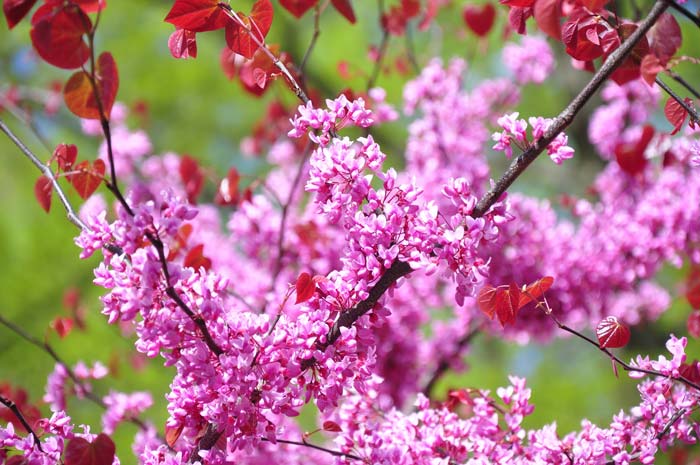

Flowering cercis
If you plan to plant several trees, it is advisable to maintain a distance of several meters between individual specimens. Otherwise, the seedlings will begin to compete fiercely with each other in an attempt to grow as big and beautiful as possible.
General characteristics and types
Any gardener dreams of growing this exotic culture on his site. The genus Cercis is represented by thermophilic, deciduous shrubs and trees with stunningly spectacular and picturesque flowers, having a lush, spreading crown, shaped like a ball or a tent. Barrels are often irregular, curved or one-sided. Cercis, or scarlet, belongs to the legume family.
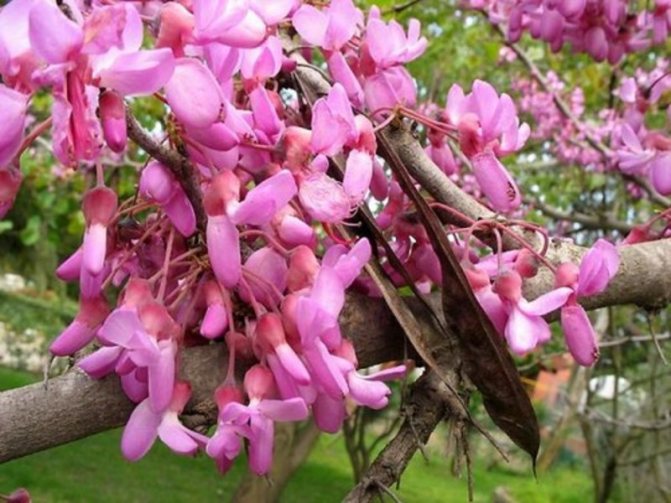

The culture is not very diverse. There are only seven of them:
- Certsis (scarlet) Chinese (C. chinensis Bunge.) Grows in China, its central and western parts.
- Certsis (scarlet) cyst (C. racemosa Oliv.) Lives in the central part of China.
- Cercis European (Cercis siliquastrum L.), or ordinary purple, grows in some regions of the ancient Mediterranean, in the southwestern part of the Pamir-Altai, in the mountainous regions of Turkmenistan, in Afghanistan, Iran and in the Shvanidzor gorge located in the Caucasus. It is this species that is called the Judas tree.
- Certsis (purple) Griffith (C. griffithii Boiss.) Grows in the same places in which the European cercis lives.
- Reniformis Engelm. Native to North America.
- Certsis (purple) western (C. occidentalis Torr.) Also lives in North America.
- Certsis (scarlet) Canadian (C. canadensis L.), like the two previous species, grows in North America.
Garden hibiscus: care and reproduction
The first four species are very fond of heat, so growing them in cold climates is problematic. The last three species are more hardy and able to withstand light frosts. Cercis, or canadian scarlet - shows the highest frost resistance .
Use in garden design
The Judah tree, when used in garden design, retains its decorative appearance all year round. In spring, gardeners can enjoy the lush flowering of the plant for a whole month, then the foliage, and in winter, pods with beans are pleasing to the eye. A single crop planting would be a good solution. So she will receive enough light and nutrients from the soil to show herself in all her beauty.Certsis also looks great in compositions with coniferous shrubs (juniper, thuja, dwarf pine and spruce trees).
If a scarlet alley is planted, a distance of at least 0.8–1.0 m should be left between the specimens. With further growth, they will not interfere with each other. The plant looks organically in oriental-style gardens.
The Judas tree hedge is thick and attractive, but remember that the plant grows slowly, and therefore you need not overdo it with curly pruning.
In general, cercis will not cause much trouble when growing and will become a real decoration of the garden. At all times of the year, he will rivet the eyes of household members, your guests and just passers-by.
Growing cercis from seeds
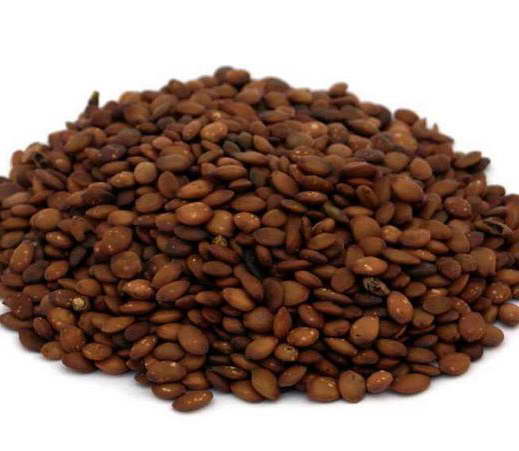

Seeds of cercis european photo
Cercis beans have a dense shell through which the sprout is not able to break through. Therefore, before sowing, they must be scarified (scalded with boiling water, kept in a solution of sulfuric acid) or stratified (held for 2-3 months at temperatures from 0 to +4 ° C, for which the vegetable section of the refrigerator is perfect). If sown in the fall or the crimson beans overwinter in pods on a tree, they will stratify naturally and the need for additional processing will disappear.
Sowing in the ground
So, cercis seeds can be sown directly into open ground. We just dig up the area, break up the breasts and level the soil. We close several beans to a depth of 3-4 cm at a distance of 15 cm from each other. We thin out the seedlings and plant them at our own discretion; the distance between adult plants should be at least 2 meters.
It is advisable to cover winter crops with peat or dry leaves; in very cold regions, it should be additionally covered with spruce branches. Keep in mind that the seeds of heat-loving varieties will sprout if the temperature in winter does not drop below 3-4 ° C with a plus sign, they are only suitable for regions with a southern climate.
Suppose spring sowing, the outside air temperature should be 15-20 ° C.
Growing cercis from seeds at home
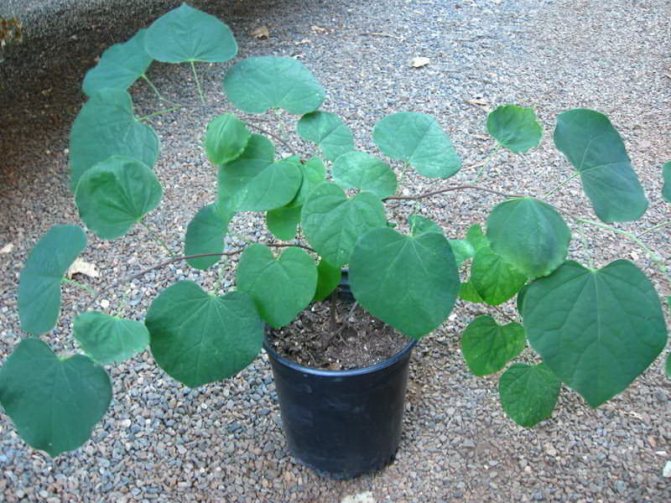

Cercis from seeds at home photo
You can plant scarlet seeds even in an apartment, start sowing from the end of February, be sure to follow the recommendations for scarification or stratification.
- You can sow one seed at a time into the cells of the seedling cassettes, filling them with nutritious loose soil.
- Embedding depth 0.5-1 cm.
- Place crops on a southern or eastern window sill, provide them with regular moisture, preferably cover with foil or glass until shoots appear. Then remove the shelter.
- The grown seedlings are transferred into separate pots, and then planted in the garden for growing.
- In the fall, the seedlings need to be dug up again and transplanted into pots in order to keep them until spring in a cool, well-lit room.
- Next spring it will be possible to plant plants in the garden; in the fall, be sure to build a good shelter for the winter in order to protect them from freezing.
Features of plant care
An important condition should be stipulated right away: cercis does not need a lot of moisture and nutrients. So, he most often extracts the latter on his own from the air and soil. As for watering, they should be moderate, but regular. This is especially important in the early years of the plant's life. In the future, the amount of moisture can be reduced.
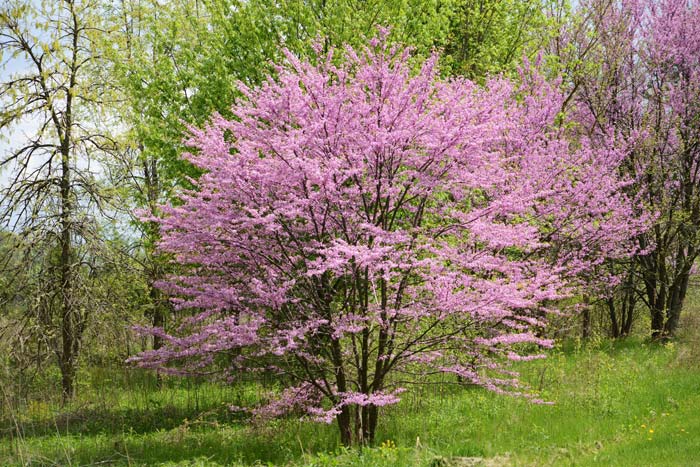

Cercis can be formally pruned
In the spring, it is advisable to whitewash the trunk, and mulch the trunk circle well. With the onset of autumn, it is advisable to cut off already grown and matured trees to form a lush and even crown in the spring. The branches can be shortened by a maximum of one third, it is imperative to remove the root growth.
Cercis is considered a slow-growing plant, but gardeners' reviews indicate that it often grows quickly in height already in the first year of its life.
Advice.In the first year of a scarlet tree's life, it is undesirable to prune its crown: it is best to do this only by the 3rd year of its stay in the garden. But after 5-6 years, it is better to stop pruning altogether. Only in the spring is it possible to carry out sanitary pruning of branches frozen over the winter.
This concludes our acquaintance with the features of planting and caring for cercis in the open field. Good luck!

